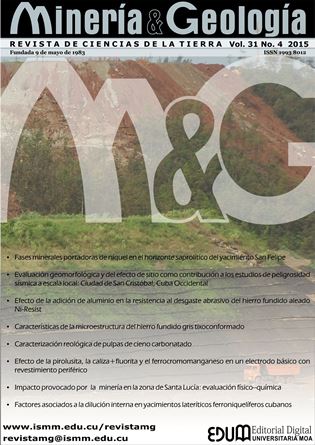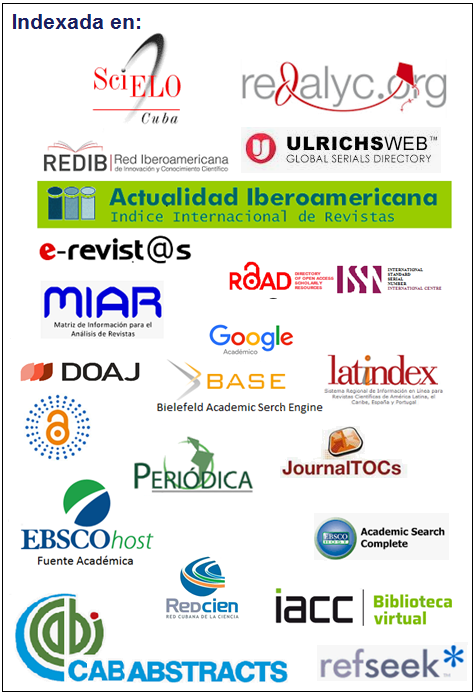Aluminum addition effect to the resistance of the Ni-resist alloy cast iron to abrasion wear
Keywords:
aluminum, alloying element, Ni-Resist alloy, resistance to wear, intermetallic compounds, particle precipitation, alloyed ironAbstract
The objective of this investigation is to increase the resistance toabrasion of the NI-Resist cast iron alloy through particle precipitation while maintaining chemical stability unchanged by adding aluminum asintermetallic compound inducer. This contributes to the formation orprecipitation of homogenous particles. Ni-Resist alloy samples types 2and 3 were used maintaining nickel percent unchanged while varying thealuminum content. Aging thermal treatment was applied to induce theparticles. The results indicated that the addition of aluminum as analloying element to the Ni-Resist alloy increases the resistance to wearthrough particle precipitation due to its capacity as an intermetallic compound inducer. 0.5% aluminum addition produced the best results.Downloads
References
ASTM. A 247-67. 1998: Standard Test Method for Evaluating the Microstructure of Graphite in Iron Casting.
ASTM. A 436-84. 1997: Standard Specification for Austenitic Gray iron Castings.
GROSDIDIER, T.; HAZOTTE, A. & SIMON, A. 1998: Precipitation and dissolution processes in gamma gamma' single-crystal nickel-based superalloys. Materials science & engineering: A 256(1): 183-196.
ISHIKAWA, S.; YAMAMOTO, A. & KYOSHIOKA. 2001: High alloy cast iron excellent in wear resistance. Japanese Patent JP2001316754. November 16.
KRAUSE, D. E. 1969: Gray Iron -A Unique Engineering Material. ASTM, Special Technical Publications 455: 3-28, Philadelphia.
MAEDORO, H. & SEIJI, N. 2001: Wear resistant alloy cast iron material. Japanese Patent JP2001081527. March 27.
MARIÑO, C. M. 2008: Incremento de la termo-resistencia de la aleación ACI HK40 por precipitación de partículas coherentes. Tesis doctoral. Instituto Superior Minero Metalúrgico. Cuba.
MARIÑO, C. M.; VELÁZQUEZ, A.; ALFONSO, E. & FELIÚ, M. 2008a. Design of a creep resistant iron-base superalloy for Herreshoff furnaces. Part I– Mechanical properties modelling and phase diagram simulation. Minería y Geología 24(3).
MARIÑO, C. M.; VELÁZQUEZ, A.; ALFONSO, E. & FELIÚ, M. 2008b. Design of a creep resistant iron-bas superalloy for Herreshoff furnaces Part II– Experimental results. Minería y Geología 24(4): 83-87.
PLATI, A. 2003: Modelling of γ′ Precipitation in Superalloys. Materials Science and Metallurgy Department, University of Cambridge, 1-4.
SIERPINSKI, Z. & JANUSZ, G. 1999: Phase transformations and strengthening during ageing of CuNi10Al3 alloy. Materials Science and Engineering: A 264(1–2): 279–285.
SOURMAIL, T. 2001: Precipitation in creep resistant austenitic stainless steels. Materials science and technology 17(1): 1-14.
SY, A. D. 1959: Copper in cast iron. Principal Considerations. AFS Transactions 67: 321-328.
WALTON, C. F. & OPAR, T. J. 1981: Iron casting handbook covering data on Grey. Malleable and ductile iron. Iron casting Society Inc., New York.
YAMAMOTO, M. & HIROAKI, M. 2001: Wear resistant alloy cast iron material. Japanese Patent Jp2001049381. February 20.
Published
How to Cite
Issue
Section
- Authors retain copyright and guaranteeing the right magazine to be the first publication of the work as licensed under a Creative Commons Attribution-NonCommercial that allows others to share the work with an acknowledgment of the work's authorship and initial publication in this journal.
- Authors may establish separate supplemental agreements for the exclusive distribution version of the work published in the journal (eg, place it in an institutional repository or publish it in a book), with an acknowledgment of its initial publication in this journal.
- Authors are allowed and recommended to disseminate their work through the Internet (e.g., in institutional telematic archives or on their websites) before and during the submission process, which can produce interesting exchanges and increase citations of the published work. (See The effect of open access)




